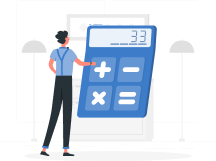
Select City
USFDA-Approved Procedure

Support in Insurance Claim

No-Cost EMI

1-day Hospitalization

Cholecystitis is a condition in which the gallbladder, a small, pear-shaped organ underneath your liver, gets inflamed. The gallbladder’s primary function is storing bile, a digestive fluid produced by the liver. The inflammation usually results from a blockage in the bile duct, typically caused by gallstones. This condition can be acute, emerging suddenly, or chronic, developing over time.
In India, cholecystitis is quite common among all age groups due to the high prevalence of gallstones and unhealthy dietary patterns. Patients often delay seeking medical help due to a lack of awareness about the symptoms and severity of this condition. Hence, it is important to consult with a seasoned family physician or surgeon if you experience any symptoms of cholecystitis.
Cholecystitis has two main types: acute and chronic. They are characterised as follows:
It can be further classified as Calculous Cholecystitis which is the most common type, caused by gallstones obstructing the cystic duct. Another is Acalculous Cholecystitis which occurs without gallstones and is often associated with serious conditions such as trauma or infections.
Understanding these types of cholecystitis can aid in the timely diagnosis and determination of appropriate treatment strategies.
Cholecystitis, or gallbladder inflammation, often arises due to various underlying conditions or influences. The most common contributors are:
If you are suffering from cholecystitis, you are likely to experience the following symptoms:
In the case of chronic cholecystitis, the symptoms include:
The diagnosis of cholecystitis involves a combination of clinical evaluation, laboratory tests, and imaging.
Treating cholecystitis primarily depends on its severity and whether it is acute or chronic. In most cases of acute cholecystitis, hospitalisation is required for close observation and treatment.
With appropriate treatment and early diagnosis, patients with cholecystitis generally have a good prognosis. It’s crucial to seek medical attention promptly if you suspect cholecystitis based on symptoms like severe abdominal pain.
Cholecystitis can result in major complications if left untreated. It is considered serious under these conditions:
Although preventing cholecystitis might not be entirely possible, one can take steps to reduce their risks. Maintaining a healthy weight and avoiding rapid weight loss can help, as obesity and sudden weight loss could increase your risk of gallstones—a primary cause of cholecystitis.
Regular exercise and a balanced diet low in fats and high in fibre can also help maintain good gallbladder health. It is always recommended to visit your family doctor if you have persistent abdominal pain.
If you’re experiencing persistent or severe abdominal pain, high fever, or yellowing of the skin and eyes (jaundice), it’s time to consult a doctor. A gastroenterologist specialising in digestive system disorders may be the most appropriate person to consult. Timely diagnosis and treatment of cholecystitis are crucial to prevent serious complications.


Cholecystitis often arises due to gallstones, small mineral deposits formed in your gallbladder, blocking the bile duct. When this duct is blocked, the bile stagnates and causes your gallbladder to inflame, leading to cholecystitis. Other factors, such as tumours or severe illness, can also cause this condition.
While medical intervention is often required for cholecystitis, some lifestyle changes can help manage the condition. These include adopting a healthy eating pattern with plenty of fruits and vegetables while avoiding fatty and fried foods.
While mild cases may improve with conservative management, most cases require medical intervention to prevent complications.
While it may not always be possible to prevent cholecystitis, getting routine health checkups and maintaining a healthy weight can reduce your risk. It’s also beneficial to follow a balanced diet, enriched with whole grains, lean proteins, fruits, and vegetables.
The recovery time for cholecystitis largely depends on its severity and the type of treatment given. If treated timely and appropriately, many people make a full recovery within a few weeks.
Yes, even after successful treatment, cholecystitis can recur, particularly if the underlying causes are not addressed. Regular follow-ups with your doctor are crucial to monitor your condition and manage any recurring symptoms.
After undergoing surgery for cholecystitis, it’s essential to rest and give your body time to heal. You should also follow a healthy, balanced diet and avoid foods that can stress the liver or cause indigestion. Regular gentle exercise is also beneficial once your doctor gives you the all-clear.
Yes, it’s completely safe to live without a gallbladder. It doesn’t affect your ability to digest food but may cause diarrhoea initially, which usually improves over time.
The risk increases with age; older adults are more likely to develop gallstones and subsequent complications like cholecystitis.
Yes, individuals with diabetes are at a higher risk for complications related to cholecystitis due to potential delays in seeking treatment and impaired immune response.